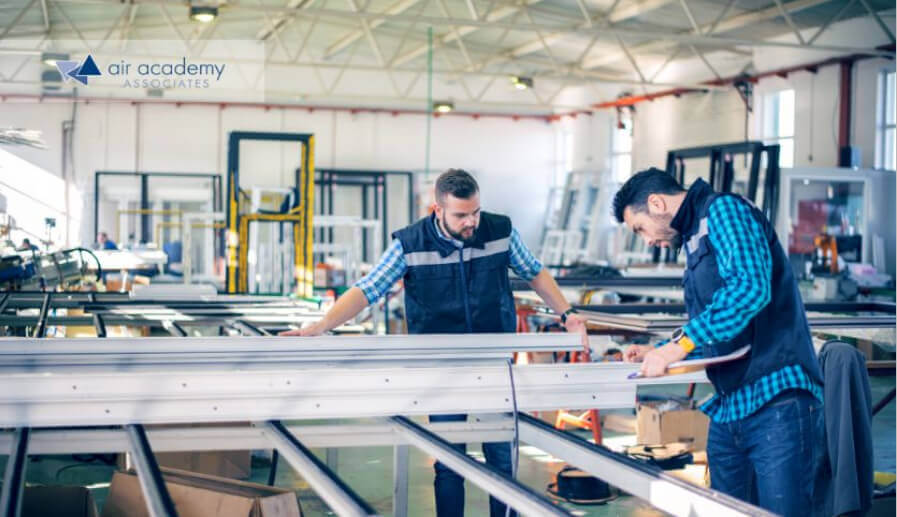
Design of Experiments (DOE) is a systematic method used in manufacturing to enhance process efficiency, improve product quality, and reduce costs. It involves planning, conducting, and analyzing controlled tests to examine the effects of various input variables on output results. This technique enables manufacturers to make data-driven decisions, streamline production processes, and achieve continuous improvement.
Key Takeaways
- DOE enhances manufacturing efficiency and quality by optimizing process parameters and reducing variability.
- It addresses sustainability and digital transformation, aligning with the future trends of intelligent manufacturing.
- The methodology facilitates knowledge transfer in the workforce, addressing talent gaps and enhancing productivity.
- Air Academy Associates‘ Operational Design of Experiments Course empowers professionals to apply DOE effectively in operational contexts.
How DOE Works

Design of Experiments (DOE) in manufacturing is a structured, systematic method for determining the relationship between factors affecting a process and the output of that process. It is used to identify the conditions that optimize manufacturing operations’ quality, efficiency, and productivity. Here’s a comprehensive look at how DOE is applied in the manufacturing industry:
Planning the Experiment
- Objective Definition: The first step involves clearly defining the experiment’s goals. These could range from reducing waste in a production process to improving the quality of the finished product.
- Selection of Factors: Identify the input variables influencing the process outcomes. These can include material types, machine settings, environmental conditions, etc.
- Choosing a Design: Select an appropriate experimental design based on the objectives, the number of factors, and the interactions that need investigation. Common designs include Full Factorial, Fractional Factorial, and Response Surface Methodology (RSM).
Conducting the Experiment
- Setting Levels for Factors: For each factor identified, decide on the levels (values) at which it will be tested. These levels typically include a high and a low value to understand the factor’s effect on the output.
- Randomization: To avoid bias, experiments are randomized. This means the order in which tests are conducted is determined randomly, helping to ensure that external variables do not skew results.
- Replication: Repeating the experiments helps obtain a more accurate estimate of the effect of factors by reducing the variability in the results due to uncontrolled variables.
Analyzing Results
- Data Analysis: The collected data is analyzed using statistical software after the experiments. This analysis helps understand each factor’s effects and interactions on the output.
- Modeling: The analysis results in a mathematical model that predicts the process output based on the input variables. This model is invaluable for optimizing the process.
- Optimization: The model determines the optimal conditions for the manufacturing process. These conditions meet the experiment’s objectives, such as maximizing output quality or minimizing costs.
Applying Findings
- Validation: The optimal conditions identified are then validated by conducting additional experiments under these conditions to confirm the expected improvements are realized.
- Implementation: Once validated, the optimal process settings are implemented in the production environment.
- Continuous Improvement: DOE is an iterative process. Based on the results and the changing business or production environment, further experiments can be planned and conducted to improve the process continuously.
This structured approach to experimentation allows manufacturers to make informed decisions, leading to significant improvements in product quality, process efficiency, and cost-effectiveness. By systematically exploring the effects of various factors and their interactions, DOE helps uncover deeper insights into manufacturing processes, enabling businesses to achieve operational excellence.
Benefits of Implementing DOE

The Design of Experiments (DOE) methodology is pivotal in optimizing manufacturing processes, ensuring product quality, and fostering innovation within the industry. Here are five crucial benefits of DOE, each elaborated with instances and insights drawn from multiple sources:
Enhanced Process Efficiency and Productivity
DOE enables manufacturers to systematically test and identify the optimal settings for various process parameters.
For instance, in automotive manufacturing, DOE can be utilized to refine the paint application process by experimenting with factors such as paint viscosity, application method, drying time, and temperature. By identifying the optimal combination of these factors, manufacturers can achieve a consistent and high-quality finish across all products, significantly reducing defects and rework costs.
Improved Product Quality
Through DOE, manufacturers can isolate and evaluate the impact of individual factors on the final product quality. This systematic approach reduces product variability and defects.
For example, in the pharmaceutical industry, DOE can be employed to determine the ideal conditions for drug formulation processes, ensuring that each batch meets stringent quality standards. Manufacturers can produce medications with consistent potency and purity by optimizing ingredient ratios, mixing times, and temperatures.
Cost Reduction
By pinpointing the most significant factors influencing production outcomes, DOE helps manufacturers eliminate unnecessary expenses associated with over-engineering and wasteful practices. In lean manufacturing, DOE can identify areas where resources are being underutilized or wasted, such as inventory management, leading to a more efficient use of materials and labor. This reduces production costs and minimizes environmental impact through reduced waste.
Informed Decision-Making
The data and insights generated by DOE empower manufacturers with evidence-based knowledge to make informed decisions. This moves the decision-making process from intuition or guesswork towards a more analytical and statistical foundation.
For example, in the electronics manufacturing sector, DOE can be used to assess the reliability of different soldering materials and techniques under various conditions. The results of such experiments provide solid data to guide the selection of materials and methods that will yield the most durable and reliable electronic components.
Faster Time to Market
DOE accelerates the product development cycle by quickly identifying the optimal process parameters for new products. This is especially crucial in industries where speed to market is a competitive advantage, such as in consumer electronics. By employing DOE to test and validate product designs and manufacturing processes early in the development phase, companies can reduce the time required for testing and refinement, enabling them to launch new products more swiftly and efficiently.
Implementing DOE in manufacturing streamlines production processes, enhances product quality, reduces costs, and supports strategic decision-making. By embracing DOE, manufacturers can stay competitive in a rapidly evolving market, continuously improve their operations, and deliver products that meet or exceed customer expectations.
Practical Applications of DOE in Manufacturing

Design of Experiments (DOE) is a powerful methodology widely applied across various manufacturing sectors to optimize processes, enhance product quality, and innovate product development. Here are four compelling applications of DOE in manufacturing, illustrating its versatility and impact:
Chemical Industry
In the chemical manufacturing sector, DOE is utilized to develop processes that reduce waste, improve the environmental footprint, and adapt to market scarcities by identifying suitable ingredient substitutions.
This application is crucial during supply chain disruptions or when facing stringent environmental or health and safety regulations. By applying DOE, manufacturers can efficiently explore alternative materials or processes with fewer experiments, saving time and resources while maintaining product quality.
Six Sigma in Manufacturing
DOE is pivotal in Six Sigma initiatives, focusing on increasing product quality and yield and reducing costs.
For example, National Semiconductor leveraged DOE alongside Six Sigma to identify and mitigate manufacturing inefficiencies, significantly increasing machine throughput and operating efficiency without compromising product quality. This approach emphasizes the importance of understanding product sensitivities and root causes of inefficiencies to enhance manufacturing performance.
Pharmaceutical Industry
In pharmaceuticals, DOE is integral during drug formulation and production to ensure quality control and efficiency.
For instance, Ono Pharmaceutical employed DOE to optimize manufacturing operations, significantly reducing impurities in the production phase by understanding the interaction among multiple manufacturing parameters. This application of DOE enabled the creation of a matrix that identified optimal conditions for producing high-quality pharmaceutical ingredients.
Fast-Moving Consumer Goods (FMCG) Industry
DOE is applied extensively in the FMCG industry, particularly in product development and consumer studies.
Procter & Gamble, for example, utilized DOE to optimize resource allocation in consumer studies, enabling the company to focus on key factors influencing consumer preferences while minimizing research costs. This strategic application of DOE allows FMCG companies to develop winning products more efficiently by collecting and analyzing data in a structured manner to make informed decisions.
These examples underscore the value of DOE in enabling manufacturers to systematically investigate and optimize various factors affecting their processes and products. By leveraging DOE, companies across different industries can significantly improve process efficiency, product quality, and market responsiveness, ultimately enhancing their competitive edge.
Future Trends in DOE and Manufacturing

The future of Design of Experiments (DOE) in manufacturing closely aligns with broader trends toward digital transformation, sustainability, and the integration of advanced technologies. Here are some pivotal areas where DOE is expected to play a significant role, along with industry trends that will shape the future of manufacturing:
- Digital Transformation and Smart Manufacturing: The manufacturing industry is increasingly adopting smart factory approaches and exploring the industrial metaverse. Integrating generative AI (GenAI) into manufacturing processes is anticipated to create efficiencies by enabling closed-loop systems that adjust in real time. This technological evolution facilitates a more agile response to market demands and enhances operational efficiency.
- Sustainability and Decarbonization: Technology is a crucial enabler as manufacturers face pressure to meet net-zero emissions goals. Innovations such as digital twins, 3D modeling, and IoT are laying the groundwork for leveraging the industrial metaverse, projected to drive significant revenue and support decarbonization efforts. This shift towards digitalization improves equipment effectiveness and aligns with sustainability objectives by reducing waste and enhancing “green” operations.
- Labor Productivity and Knowledge Transfer: The aging workforce and talent retention challenge are prompting manufacturers to look at ways to preserve critical knowledge and skills. Setting up alumni programs for retired employees can facilitate the transfer of expertise to younger workers, ensuring that valuable institutional knowledge is not lost. This approach is part of broader efforts to address labor shortages and skills gaps, ensuring the industry is better equipped to predict and manage future challenges.
- Customization and Consumer Demands: The demand for customized goods has led manufacturers to emphasize digital agility. By leveraging digitization, manufacturers can achieve high-volume/low-cost production that is profitable and responsive to consumer preferences for personalized products. This shift is part of a larger trend towards nimble, agile operations that can quickly adapt to changing market conditions.
- Cybersecurity and System Integration: As manufacturing technologies evolve, there’s a trend towards collapsing the traditional ISA-95 tech stack to drive efficiencies and make systems more integrated. This requires a careful balance between innovation and cybersecurity, as more integrated systems may be vulnerable to cyber threats. Manufacturers must prioritize security as they streamline their operations.
Conclusion
Design of Experiments (DOE) is a cornerstone in advancing manufacturing processes, enabling businesses to optimize performance, enhance quality, and drive innovation efficiently. In an era where digital transformation, sustainability, and smart manufacturing are paramount, DOE’s role is ever-expanding, offering a pathway to harnessing the full potential of emerging technologies like generative AI and navigating the challenges of a rapidly evolving industry landscape.
At Air Academy Associates, we’re at the forefront of equipping professionals with the knowledge and tools necessary to leverage DOE for operational excellence. Our Operational Design of Experiments Course is meticulously designed for practitioners seeking to apply DOE in real-world scenarios, ensuring they maximize learning while minimizing resource expenditure. We invite you to explore our course and embark on a journey to mastering DOE, unlocking new levels of efficiency and innovation within your organization.


